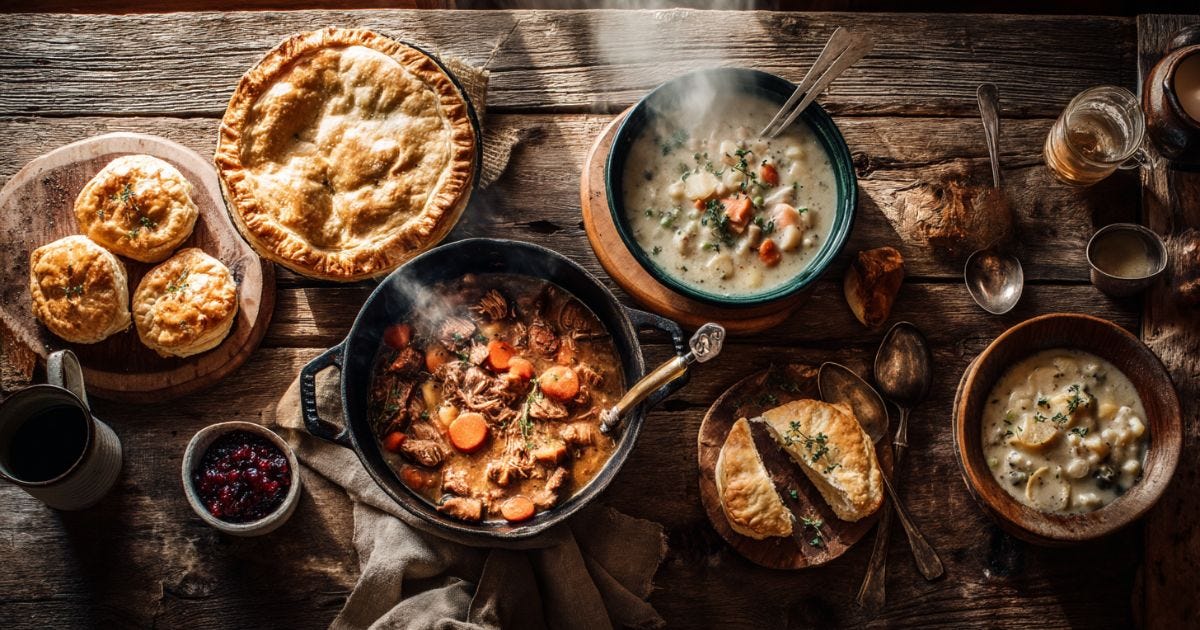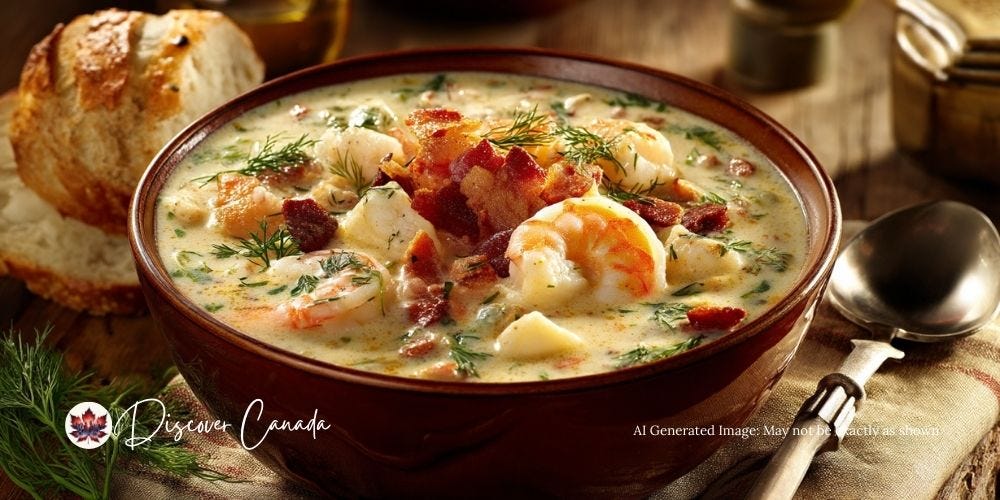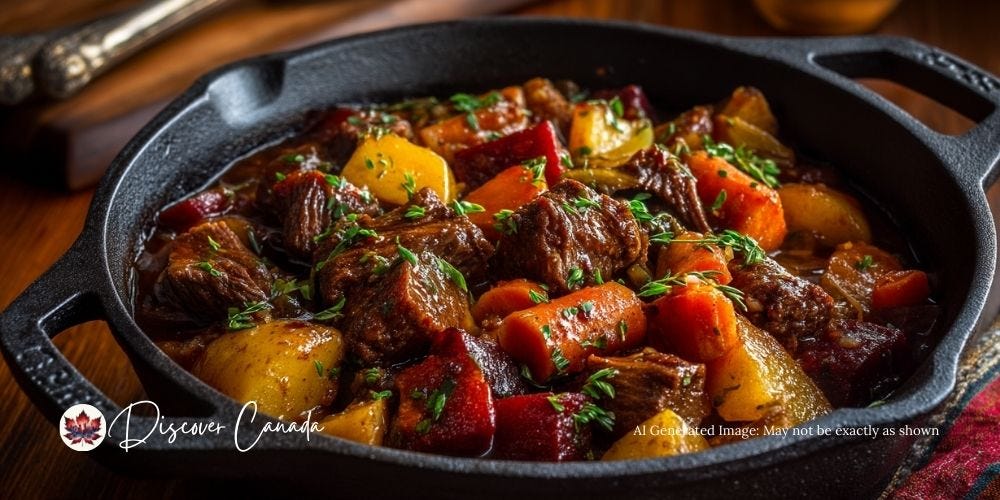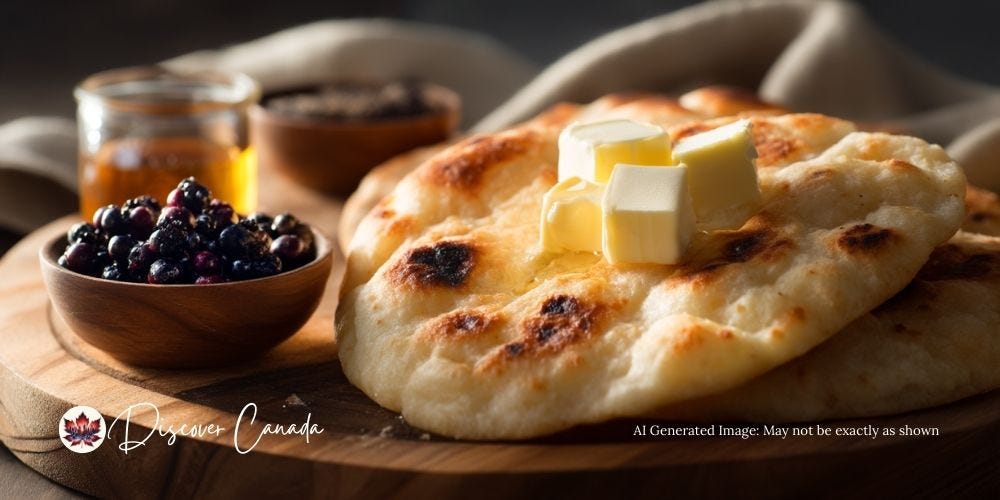5 Cozy Canadian Recipes for Cold Winter Nights
Comfort food classics from coast to coast

Listen While You Read 🎧
Hit play on the audio version and let the words warm you like a simmering stew on a snowy night.
5 Cozy Canadian Recipes for a Cold Winter’s Night
Introduction
Picture this: you’ve just come in from the cold, brushing snow off your coat as the windows fog from the warmth inside. The scent of something rich and hearty fills the kitchen — spices simmering, bread baking, broth bubbling.
Canada’s winters may be long and frosty, but they’ve inspired some of the world’s most comforting dishes. From the flaky, spiced tourtière of Québec to the creamy seafood chowders of the East Coast, each recipe is more than a meal — it’s a story, rooted in region and tradition.
These Canadian comfort food recipes aren’t just about feeding the body; they’re about celebrating culture, memory, and the joy of gathering around the table when the nights grow long.
🍲 Key Takeaways from this Article
🇨🇦 Discover five iconic Canadian recipes — from bison stew on the Prairies to bannock with wild berries in the North.
❄️ Learn how Canadians have turned cold winters into culinary inspiration, creating dishes that comfort and connect.
🥖 Get full ingredients and step-by-step recipes so you can bring these traditions to your own kitchen.
🍷 Find pairing ideas — from Canadian wines to craft beers — that make each dish shine.
Tourtière – The Classic Québécois Meat Pie
Backstory
In the deep winters of Québec, few dishes carry more tradition than the tourtière. This spiced meat pie dates back to the 1600s, when French settlers prepared hearty game pies to withstand the cold. Over time, the recipe evolved into a mixture of ground pork, beef, or veal seasoned with cinnamon, cloves, and allspice — warm spices that feel almost festive.
Today, tourtière is more than food: it’s a ritual. Families across Québec and beyond gather to share it on Christmas Eve, New Year’s Day, or simply during a long winter’s night. Each bite tells the story of French-Canadian resilience and the art of transforming simple ingredients into unforgettable comfort.
Ingredients
1 lb (450 g) ground pork
½ lb (225 g) ground beef (or veal)
1 medium onion, finely chopped
2 cloves garlic, minced
1 cup (240 ml) beef broth
1 medium potato, peeled and grated
½ tsp ground cinnamon
½ tsp ground cloves
½ tsp ground allspice
Salt and pepper, to taste
2 pie crusts (top + bottom)
Pro Tip: For the flakiest crust, chill your dough and handle it as little as possible. If you’re short on time, store-bought crust works, but brushing the top with an egg wash will give you that irresistible golden sheen.
Instructions
Preheat oven to 375°F (190°C).
In a large skillet, sauté onion and garlic until softened.
Add pork and beef; cook until browned. Drain excess fat.
Stir in spices, grated potato, and broth. Simmer until liquid reduces and mixture thickens, about 20 minutes.
Line a pie dish with bottom crust, fill with meat mixture, and cover with top crust. Crimp edges to seal.
Cut a few slits in the top to vent steam.
Bake for 40–45 minutes, or until golden brown.
Serving & Pairing Tip
Tourtière shines alongside tangy accompaniments like pickled beets or green tomato chow chow. For a drink pairing, pour a bold Canadian Pinot Noir or even a glass of mulled cider for extra winter warmth.
Atlantic Seafood Chowder – East Coast Comfort in a Bowl

Backstory
On Canada’s Atlantic coast, where icy winds whip across fishing harbors and lighthouses glow in the mist, nothing warms the soul like a steaming bowl of seafood chowder. Rooted in Maritime tradition, this dish reflects the region’s reliance on the sea — from haddock and cod to lobster, shrimp, and scallops.
Every family has its own version, passed down through generations in Nova Scotia, Prince Edward Island, and Newfoundland kitchens. Creamy, hearty, and often flecked with bacon and dill, this chowder is less a recipe than a story of the Atlantic itself: resourceful, generous, and always nourishing after a long day braving the cold.
Ingredients
2 tbsp butter
1 small onion, finely chopped
2 cloves garlic, minced
2 medium potatoes, diced
2 cups (480 ml) seafood stock or chicken broth
1 cup (240 ml) heavy cream or half-and-half
4 oz (115 g) smoked bacon, diced
½ lb (225 g) haddock or cod, cut into chunks
½ lb (225 g) shrimp, scallops, or lobster meat
1 tsp fresh dill, chopped (or ½ tsp dried)
Salt and pepper, to taste
Crusty bread, for serving
Pro Tip: For extra depth, combine fresh and smoked seafood — the smoky flavor adds complexity that rivals restaurant chowder. If lobster or scallops aren’t available, a frozen seafood medley works wonderfully without sacrificing comfort.
Instructions
In a large pot, cook bacon until crisp; set aside, leaving drippings in the pot.
Add butter, onion, and garlic; sauté until softened.
Stir in diced potatoes and stock. Simmer until potatoes are tender (about 12–15 minutes).
Lower heat and gently stir in cream, haddock, and shellfish. Cook until seafood is just opaque (5–7 minutes).
Season with dill, salt, and pepper. Stir in reserved bacon before serving.
Serving & Pairing Tip
Serve steaming hot with thick slices of crusty bread or biscuits to mop up every drop. For a drink, a crisp Nova Scotia Tidal Bay white wine or even a pint of East Coast craft ale makes the perfect partner.
Prairie Bison Stew – A Hearty Taste of the West
Backstory
Stretching across Manitoba, Saskatchewan, and Alberta, the Canadian Prairies have long been shaped by wide-open skies, resilient communities, and food rooted in survival. One dish that embodies this heritage is bison stew.
For Indigenous and Métis peoples, bison was a sacred source of both sustenance and culture. Today, the tradition continues in kitchens and restaurants across the West, where bison’s rich yet lean meat is celebrated as a healthier, more sustainable alternative to beef. Slow-simmered with root vegetables and herbs, this stew is as hearty as the Prairie landscape itself — robust, warming, and deeply satisfying on a frigid winter night.
Ingredients
2 tbsp vegetable oil
2 lbs (900 g) bison stew meat, cubed
1 large onion, chopped
2 cloves garlic, minced
3 medium carrots, sliced
2 parsnips, peeled and chopped
2 medium potatoes, diced
4 cups (950 ml) beef or game stock
1 cup (240 ml) red wine (optional, adds depth)
2 tbsp tomato paste
2 bay leaves
1 tsp dried thyme
Salt and pepper, to taste
Pro Tip: Because bison is leaner than beef, keep the simmer gentle and steady — boiling will toughen the meat. If bison is hard to find, beef chuck or venison makes an excellent substitute while staying true to the Prairie spirit.
Instructions
Heat oil in a heavy Dutch oven or stockpot over medium-high heat. Brown the bison cubes in batches; set aside.
Add onion and garlic, sauté until fragrant. Stir in tomato paste.
Return meat to the pot, pour in stock and wine, and add bay leaves and thyme.
Bring to a boil, then reduce heat. Cover and simmer gently for 2 hours.
Add carrots, parsnips, and potatoes. Continue simmering until vegetables and meat are tender (30–40 minutes).
Adjust seasoning before serving.
Serving & Pairing Tip
Bison stew begs for buttery mashed potatoes or warm bannock on the side. For a drink, pair it with a Prairie craft beer or a glass of smooth Canadian rye whiskey to echo the stew’s hearty flavors.
West Coast Salmon Chowder – Pacific Comfort with a Coastal Twist
Backstory
On Canada’s Pacific shores, the ocean shapes both landscape and lifestyle. Few dishes capture this connection better than a creamy salmon chowder. Indigenous communities have fished Pacific salmon for thousands of years, smoking and preserving it to sustain families through long winters. Today, this tradition lives on in a coastal chowder that is lighter than its Atlantic cousin but every bit as comforting.
Infused with leeks, dill, and tender chunks of salmon, this chowder reflects British Columbia’s culinary spirit: fresh, nourishing, and deeply tied to the rhythms of the sea. It’s the kind of dish that brings people together on misty evenings when the rain patters against cedar shingles and the kitchen glows warm.
Ingredients
2 tbsp butter or olive oil
1 leek, white and light green parts, sliced
2 medium carrots, diced
2 medium potatoes, diced
3 cups (710 ml) fish or chicken stock
1 cup (240 ml) heavy cream or milk
1 lb (450 g) fresh salmon fillet, skin removed and cut into chunks
½ cup (120 ml) corn kernels (fresh or frozen)
1 tsp fresh dill, chopped
Juice of ½ lemon
Salt and pepper, to taste
Pro Tip: Add the salmon only at the end of cooking — just enough time to turn opaque and flake gently. This keeps it tender and prevents it from falling apart. A splash of white wine in the broth adds subtle brightness.
Instructions
In a large pot, melt butter and sauté leeks and carrots until softened.
Add potatoes and stock; simmer until potatoes are just tender (about 12 minutes).
Reduce heat and stir in cream.
Gently add salmon chunks and corn. Cook 5–7 minutes, until salmon is just cooked through.
Stir in dill, season with salt and pepper, and finish with a squeeze of lemon juice.
Serving & Pairing Tip
This chowder pairs beautifully with sourdough bread or a side salad of crisp greens. For drinks, a chilled glass of Okanagan Valley Pinot Gris or a tart craft cider from Vancouver Island highlights the freshness of the salmon.
Northern Bannock with Wild Berries – Simple, Sweet, and Traditional
Backstory
For centuries, bannock has been a staple of Indigenous communities across Canada. Originally made with stone-ground flours, wild berries, and rendered fat, it was baked over an open fire or fried in cast iron. Bannock was practical — easy to carry, nourishing, and versatile — but it was also deeply symbolic of community and survival through Canada’s long winters.
Today, bannock is both a comfort food and a cultural touchstone. Whether fried to a golden crisp or baked soft and fluffy, it’s served with everything from hearty stews to sweet toppings like maple syrup or Saskatoon berry jam. On a cold night, few things feel as comforting as a warm piece of bannock shared at the table.
Ingredients
2 cups (250 g) all-purpose flour
1 tbsp baking powder
½ tsp salt
2 tbsp butter or lard, chilled and cubed
¾ cup (180 ml) water or milk
Optional: ½ cup wild berries (blueberries, Saskatoon berries, or cranberries)
Pro Tip: Bannock is wonderfully flexible: bake it for a softer, bread-like version, or fry it for a crisp, indulgent treat. It’s best enjoyed fresh, but you can reheat leftovers in the oven wrapped in foil to revive that just-baked warmth.
Instructions
Preheat oven to 400°F (200°C) or heat oil in a heavy skillet if frying.
In a bowl, combine flour, baking powder, and salt. Cut in butter until mixture resembles coarse crumbs.
Stir in water or milk just until dough comes together. (Add berries if using.)
For baking: pat into a round loaf about 1-inch thick, place on a baking sheet, and bake 20–25 minutes.
For frying: shape dough into small rounds, fry in hot oil until golden brown on both sides.
Serving & Pairing Tip
Serve warm with butter and maple syrup, or top with jam made from local berries. A steaming mug of tea or hot chocolate makes the perfect companion.
Conclusion
When winter presses in and the nights stretch long, food becomes more than sustenance — it becomes a kind of ritual comfort. These Canadian comfort food recipes aren’t just about filling plates; they’re about telling stories of place, tradition, and resilience. From the flaky crust of a Québec tourtière to the sweet simplicity of bannock, each dish is a reflection of Canada’s diverse heritage and the shared joy of gathering around the table.
So the next time the snow falls heavy and the wind rattles the windows, let these recipes bring warmth to your kitchen. After all, few things taste better than a meal with history, heart, and just the right touch of Canadian coziness.
Frequently Asked Questions
Here are some common questions about Canadian comfort food, answered simply:
What is the most popular Canadian comfort food?
Tourtière is often considered the most iconic Canadian comfort dish, especially in Québec. Other contenders include poutine, butter tarts, and chowder, but tourtière stands out as a winter tradition served across generations.
What do Canadians eat in winter?
Canadians turn to hearty soups, stews, meat pies, and baked goods to warm up during the cold months. Dishes like bison stew, seafood chowder, and bannock are regional staples that reflect local ingredients and traditions.
Are these recipes beginner-friendly?
Yes — each recipe uses simple, accessible ingredients and straightforward steps. Even if you’re new to cooking, Canadian comfort foods like chowder or bannock are easy to master with a little patience.
Can I make these dishes ahead of time?
Absolutely. Stews, chowders, and tourtière taste even better the next day after flavors deepen. Bannock is best fresh, but baked loaves can be reheated in the oven to restore softness and warmth.
What drinks pair well with Canadian comfort foods?
Red wines, white wines, Canadian craft beers, and even rye whiskey pair beautifully with these recipes. For non-alcoholic options, hot apple cider or herbal teas complement the flavors and add extra coziness.
Still have questions? Drop them in the comments and share your own favorite Canadian winter dishes — we’d love to hear from you!







